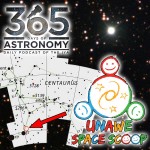Podcaster: Richard Drumm
 Title: Space Scoop: The Recipe For Our Universe
Title: Space Scoop: The Recipe For Our Universe
Organization: 365 Days Of Astronomy
Link : astrosphere.org ; http://unawe.org/kids/unawe1534/
Description: Space scoop, news for children.
Bio: Richard Drumm is President of the Charlottesville Astronomical Society and President of 3D – Drumm Digital Design, a video production company with clients such as Kodak, Xerox and GlaxoSmithKline Pharmaceuticals. He was an observer with the UVa Parallax Program at McCormick Observatory in 1981 & 1982. He has found that his greatest passion in life is public outreach astronomy and he pursues it at every opportunity.
Today’s sponsor: This episode of “365 Days of Astronomy” is sponsored by — no one. We still need sponsors for many days in 2015, so please consider sponsoring a day or two. Just click on the “Donate” button on the lower left side of this webpage, or contact us at signup@365daysofastronomy.org.
Transcript:
This is 365 Days of Astronomy. Today we bring you a new episode in our Space Scoop series. This show is produced in collaboration with Universe Awareness, a program that strives to inspire every child with our wonderful cosmos.
Today’s story is…
The Recipe For Our Universe
Looking to cook up a Universe just like ours? You’ll need the following ingredients to begin:
3 cups of Hydrogen
1 cup of Helium
A pinch of Lithium
A dash of Beryllium
Now, simply squash everything down into an impossibly tiny ball and move back to a safe distance ready for the Big Bang!
This is the recipe for our Universe. Well, you might need to scale the recipe up a bit. I think there’s more baryonic matter, the ordinary matter like you & I are made from, in the current Universe, so you’ll have to scale up the recipe quite a bit. Just keep the proportions the same. In the beginning it really was made up of just these four basic elements.
Now it’s almost 14 billion years since the Big Bang and there are 92 elements in space. These elements make up everything in the Universe, from the gigantic stars to the smallest insects, and even your favorite chocolate cookies!
We know where the 88 new elements came from (they were cooked up inside stars and blasted out into space in supernova explosions) but there are still some mysteries. The most puzzling unsolved mystery revolves around the element lithium.
Lithium was one of the first elements in the Universe, but trying to understand the amount of lithium seen in our galaxy today gives astronomers headaches. Older stars have less lithium than expected, and some younger stars have up to ten times more!
Recently, astronomers have for the first time spotted lithium being thrown into space by an exploding star called a Nova. Novas are stars that can suddenly and violently explode, throwing gases from inside them out into space.
A nova is the smaller brother of a Type 1A Supernova in that they both involve a white dwarf in a binary system that accretes hydrogen from the other star in the system.
But unlike the supernova, where the white dwarf is destroyed in a huge and devastating explosion, the more gentle nova explosion doesn’t destroy the white dwarf. Some novae are recurring, coming back every few decades to shine again.
Even though the amount of lithium created by this nova is tiny, there have been many billions of novas in the history of the Milky Way. If each one of these novas is spitting out the same tiny amount of lithium, they would easily make enough to explain the high levels we’ve seen in young stars!
For astronomers making these new observations it was like finding a long-lost jigsaw piece for a giant, cosmic puzzle! They’d been looking for this for over 25 years! The Italian and Chilean team of astronomers used the ESO’s 2.2 meter telescope La Silla Observatory and the half meter telescope at the Observatory of the Pontifica Universidad Catolica de Chile to make the discovery.
These comparatively small telescopes, equipped with suitable spectrographs, are powerful tools for this kind of research. Even in the era of extremely large telescopes smaller telescopes dedicated to specific tasks can remain very valuable.
The lithium was ejected from the nova at 2 million kilometers per hour from Nova Centauri 2013, which, as you might guess, is in the constellation Centaurus in the southern skies. The nova was close to Beta Centauri, which is itself next to Alpha Centauri, the closest star system to our own.
Hey Here’s a Cool Fact:
It isn’t just astronomers that get excited about lithium, it’s useful down here on Earth too. For example, most rechargeable batteries contain lithium.
The Great Red Spot has been seen to be shrinking lately, but it is unknown if this is a permanent situation or a cyclical effect as the spot has disappeared from time to time in the past.
The word “Jupiter” comes from the Proto-Indo-European language’s name *Dyēu-pəter which suggests a translation to “God Father Hmmm… I wonder if the planet will make us an offer we can’t refuse?
Thank you for listening to 365 Days of Astronomy!
End of podcast:
365 Days of Astronomy
=====================
The 365 Days of Astronomy Podcast is produced by NUCLIO. Audio post-production by Richard Drumm. Bandwidth donated by libsyn.com and wizzard media. You may reproduce and distribute this audio for non-commercial purposes. Please consider supporting the podcast with a few dollars (or Euros!). Visit us on the web at 365DaysOfAstronomy.org or email us at info@365DaysOfAstronomy.org. This year we celebrate cosmic light as light is our info messenger in the universe. Join us and share your story to celebrate the International Year of Light. Until tomorrow! Goodbye!

